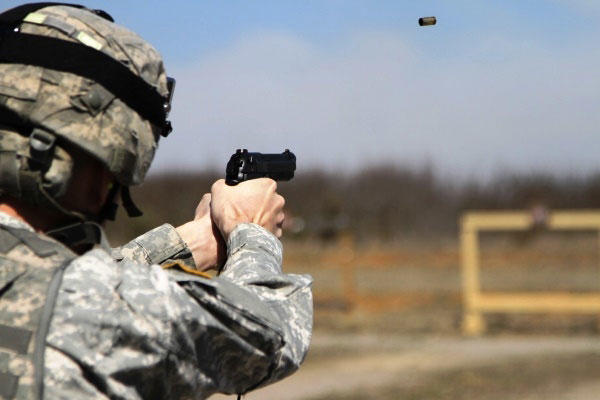The U.S. Army will continue with its Modular Handgun System effort despite heavy criticism from the service's own chief of staff who called it too bureaucratic and costly for a low-tech item such as a pistol.
Army acquisition leaders recently attended a high-level meeting with Chief of Staff Gen. Mark Milley to determine what to do about the Modular Handgun System, or MHS, effort -- keep as is, restructure or cancel it and start over, according to an Army acquisition official, who asked to remain anonymous because he is not authorized to speak to the media.
"The decision was to stay the course with MHS," the official said.
This will likely ease a lot of worry from gun-makers competing in the effort since Milley has made no secret about his contempt for service's effort to replace the current M9 9mm pistol.
The general has used recent public appearances to chastise a bureaucratic acquisition system for making it overly complicated to field equipment in a timely manner, citing the service's MHS effort as a prime example.
But behind the scenes, Milley moved beyond criticism. His office recently asked the Army Special Operations Command's G-8 office, which oversees fielding of equipment, if there is room for the Army to join its pistol contract to buy Glock 19s, according to another Military.com source who asked to remain anonymous because he is not authorized to speak to the media.
The compact Model 19 is one of Glock's most popular handguns. New Glock 19s retail for $500-$600 each. USASOC is currently paying a base price of about $320 for each Glock 19, the source said.
With that price, the Army would pay about $91.8 million if the service were to buy 287,000 pistols, the quantity requirement outlined in the MHS effort, which is currently set to cost at least $350 million.
"The thing no one is talking about is the can of worms the chief has opened," the Army acquisition said.
"I think it is good that the Army leadership is taking a bigger role in acquisition. On the other hand, there are huge risks when people like the chief have wrong or incomplete information, or jump into the middle of an active competition, the source said. "There are certain things one does not do, unless one is willing to live with the consequences."
In this case, consequences mean the possibility of protests or lawsuits by gun makers participating in the MHS completion.
"Enough companies have submitted bids for there to be a good MHS competition," the acquisition official said. "No one is saying how many that is or who they are. If they include the larger companies … it increases the prospects for litigation because they have the requisite resources, and that is what they do."
Milley's stance on MHS continues to draw attention from Congress.
Sen. Joni Ernst, a Republican from Iowa, questioned senior Army officials about it at an April 5 hearing of the Senate Armed Services Committee's Airland Subcommittee hearing.
"This has been a real big issue," she said. "Why is it so difficult for the Army to buy a basic item like a pistol?"
Lt. Gen. John M. Murray, deputy chief of staff of the Army's office for programs, or G-8, agreed that the service has been down a "torturous path" on the handgun program.
"I will guarantee you [Gen. Milley] is involved with the testing, requirements and source selection, when we get to that point, in every intimate detail," Murray said, describing how he has had "several very long and painful meetings with him in the past week or two and dug into how we got where we are and how do we fix this."
The Army launched its long-awaited XM17 MHS competition in late August to replace its Cold War-era M9 9mm pistol. One of the major goals of the effort is to adopt a pistol chambered for a more potent round than the current 9mm. The U.S. military replaced the .45-caliber 1911 pistol with the M9 in 1985 and began using the 9mm NATO round at that time.
Gun-makers had until Feb. 12 to submit proposals to the Army.
The request for proposal calls on gun-makers to submit packages that include full-size and compact versions of their handgun as well as hundreds of thousands of rounds for testing.
One of Milley's biggest criticisms of MHS is that the testing program is scheduled to last two years and cost $17 million.
In a break from tradition, the Army is also requiring competing firms to prove that they are capable of delivering millions of rounds of pistol ammunition per month in addition to delivering thousands of new handguns per month, according to the request.
The competition will also evaluate expanding or fragmenting ammunition, such as hollow-point bullets, that have been used by law enforcement agencies for years. The Army's draft solicitation cited a new Defense Department policy that allows for the use of "special purpose ammunition."
--Matthew Cox can be reached at matthew.cox@military.com.




























